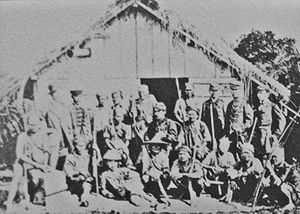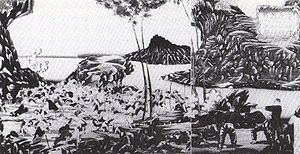- Taiwan Expedition of 1874
-
Taiwan Expedition of 1874 Part of the Formosa Conflict 
Soldiers of the Taiwan expedition.

The Battle of Stonegate (石門進撃), May 22, 1874.Date May 1874 Location Taiwan Result Japanese military victory, occupation of Taiwan, payment of indemnity by China to Japan. Territorial
changesnone Belligerents  Empire of Japan
Empire of JapanPaiwan Commanders and leaders  Saigō Tsugumichi
Saigō TsugumichiTauketok Strength Land:
3,600
Sea:
unknownunknown Casualties and losses 6 killed
~30 wounded~30 killed *531 Japanese troops are said to have died of disease during the expedition and occupation. Rover incident (1867) – American expedition (1867) – Mudan incident (1871) – Japanese expedition (1874) – Sino-French War (1884-85) - Pescadores campaign (1895) – Japanese invasion (1895)- For the 1867 expedition see Formosa Expedition.
The Taiwan Expedition of 1874 (台湾出兵 Taiwan Shuppei), usually referred to in Taiwan and mainland China as the Mudan incident (Chinese: 牡丹社事件), was a punitive expedition launched by the Japanese in retaliation for the murder of 54 Ryukyuan sailors by Paiwan aborigines near the southwestern tip of Taiwan in December 1871. The success of the expedition, which marked the first overseas deployment of the Imperial Japanese Army and Imperial Japanese Navy, revealed the fragility of the Qing dynasty's hold on Taiwan and encouraged further Japanese adventurism. Diplomatically, Japan's embroilment with China in 1874 was eventually resolved by a British arbitration which confirmed Japanese sovereignty over the disputed Ryukyu Islands in 1879.
Contents
Background
Main article: Mudan Incident of 1871In December 1871 a Ryukyuan vessel was shipwrecked near the southern tip of Taiwan. Fifty-four members of its crew of 66 were beheaded by the Paiwan aborigines. The remaining 12 crewmen were rescued by Han Chinese and were transferred to Tainan in southern Taiwan. The local Chinese government officials transferred them to Fujian province in mainland China. From there, the Qing government arranged to send them back home.[1]
Diplomacy
When Japan sought compensation from Qing China, the court rejected the demand on the grounds that the "wild"/"unsubjugated" aboriginals (traditional Chinese: 台灣生番; simplified Chinese: 台湾生番; pinyin: Táiwān shēngfān) were outside its jurisdiction. This open renunciation of sovereignty led to the Taiwan Expedition of 1874 by the Japanese.
The Meiji government of Japan demanded that the Chinese government punish leaders of the Taiwanese aborigines responsible for the murders of the Ryukyuan crew. The Japanese foreign minister Soejima Taneomi went to Beijing, and was received in an audience by the Qing Emperor Tongzhi (in itself a diplomatic triumph); however, his request for compensation was first rejected because China considered it an internal affair since Taiwan was part of Fujian Province of China and the Ryūkyū Kingdom had a tributary relationship with China. When Soejima Taneomi claimed four of the victims murdered were from Oda Prefecture, present-day Okayama Prefecture, Japan and asked for compensation again, Chinese officials refused him on the grounds that most of the Taiwanese aboriginals were outside effective Chinese control, and were thus sometimes exempt from judicial action. Charles Le Gendre, the French-born American military advisor to the Japanese government, as well as Gustave Emile Boissonade, legal advisor, urged that Japan take the matter into its own hands.
Expedition
 The Ryūjō was the flagship of the Taiwan expedition.
The Ryūjō was the flagship of the Taiwan expedition.
 The battle of Stone Gate, against the "Botan" aborigines, was the most serious encounter of the expedition[2]
The battle of Stone Gate, against the "Botan" aborigines, was the most serious encounter of the expedition[2]
The Japanese government agreed, and sent an expedition of 3,600 soldiers led by Saigō Tsugumichi in May 1874. The Japanese won a decisive victory at the Battle of Stone Gate on 22 May. 30 Taiwan tribesmen were either killed or mortally wounded in the battle, and a considerably greater number wounded. Japanese casualties were 6 killed and 30 wounded.[3]
In November 1874 the Japanese forces withdrew from Taiwan after the Qing government agreed to an indemnity of 500,000 Kuping taels. Sir Harry Parkes, the British minister to Japan, characterised this transaction as 'China's willingness to pay to be invaded'.
Aftermath
In 1875 the Qing authorities unsuccessfully attempted to bring the southeast coastal region of Taiwan under their control, despatching a column of 300 soldiers against the Paiwan. The Chinese troops were ambushed and routed by the aborigines. 250 Chinese soldiers were killed, and the 50 survivors retreated to Takow (Kaohsiung).[4]
Legacy
Although launched ostensibly to punish the local tribesmen for their murder of 54 Ryukyuan merchants, the 1874 punitive expedition to Taiwan served a number of purposes for Japan's new Meiji government. Sovereignty over the Ryukyu Islands was disputed between China and Japan, and the expedition demonstrated that China was not in effective control of Taiwan, let alone the Ryukyu Islands, and asserted Japan's right to speak for the Ryukyuan islanders. In 1879 this sovereignty dispute was referred to British arbitration, and the British confirmed Japanese sovereignty over the Ryukyus.[5] The surrendering aborigines were given Japanese flags to fly over their villages that they viewed as a symbol of peace with Japan and protection from rival tribes, however, the Japanese viewed them as a symbol of jurisdiction over the aborigines.[6]
The expedition also served as a useful rehearsal for a future Japanese invasion of Taiwan[citation needed]. Taiwan was already being viewed as a potential Japanese colony in some circles in Japan.
Domestically, the action also mollified those within the Meiji government who were pushing for a more aggressive foreign policy, and who were enraged by the government's refusal in 1873 to attack Korea. It is significant that the expedition took place shortly after the Saga Rebellion, and was led by Saigō Jūdō (Saigō Takamori's younger brother) and consisted largely of former Satsuma and Saga samurai.
More generally, the Japanese incursion into Taiwan in 1874 and the feeble Chinese response was a blatant revelation of Chinese weakness and an invitation to further foreign encroachment in Taiwan. In particular, the success of the Japanese incursion was among the factors influencing the French decision to invade Taiwan in October 1884, during the Sino-French War.
The Qing court belatedly attempted to strengthen its hold on Taiwan, and the Chinese imperial commissioner Shen Pao-chen made some improvements to the island's coastal defences during the second half of the 1870s. Further substantial improvements were made by the Chinese governor Liu Ming-ch'uan in the 1880s, in the wake of the French capture of Keelung during the Sino-French War. However, little was done to improve the poor quality of the Qing garrison of Taiwan, and both the French in 1884 and the Japanese in 1895 were able to land successfully in Taiwan.
See also
- Korean Conflict
- Japanese Conflict
- Japanese Invasion of Taiwan (1895)
- J. R. Wasson
- Punitive expedition
- Rover incident
- Mudan Incident
- Ryukyu territorial question
Notes
- ^ Davidson, 123
- ^ A Yankee in Meiji Japan: The Crusading Journalist Edward H. House By James L. Huffman, p.94 [1]
- ^ Davidson, 145–6
- ^ Davidson, 168–9
- ^ Kerr, George (2000). Okinawa: The History of an Island People (revised ed.). Tokyo: Tuttle Publishing. pp. 359–360. ISBN 0804820872.
- ^ http://www.historycooperative.org/journals/ahr/107.2/ah0202000388.html
References
- Chiu, Hungdah (1979). China and the Taiwan Issue. London: Praeger. ISBN 0030489113.
- Paine, S.C.M (2002). The Sino-Japanese War of 1894–1895: Perceptions, Power, and Primacy. London: Cambridge University Press. ISBN 0-521-81714-5.
- Ravina, Mark (2003). The Last Samurai: The Life and Battles of Saigo Takamori. Wiley. ISBN 0471089702.
- Smits, Gregory (1999). Visions of Ryūkyū: Identity and Ideology in Early-Modern Thought and Politics. Honolulu: University of Hawai'i Press.
- Davidson, J. W. (1903). The Island of Formosa, Past and Present. London.
Categories:- Meiji era
- History of Taiwan
- Taiwan under Qing Dynasty rule
- Ryukyu Islands
- Wars involving Japan
- 1874 in Taiwan
Wikimedia Foundation. 2010.
